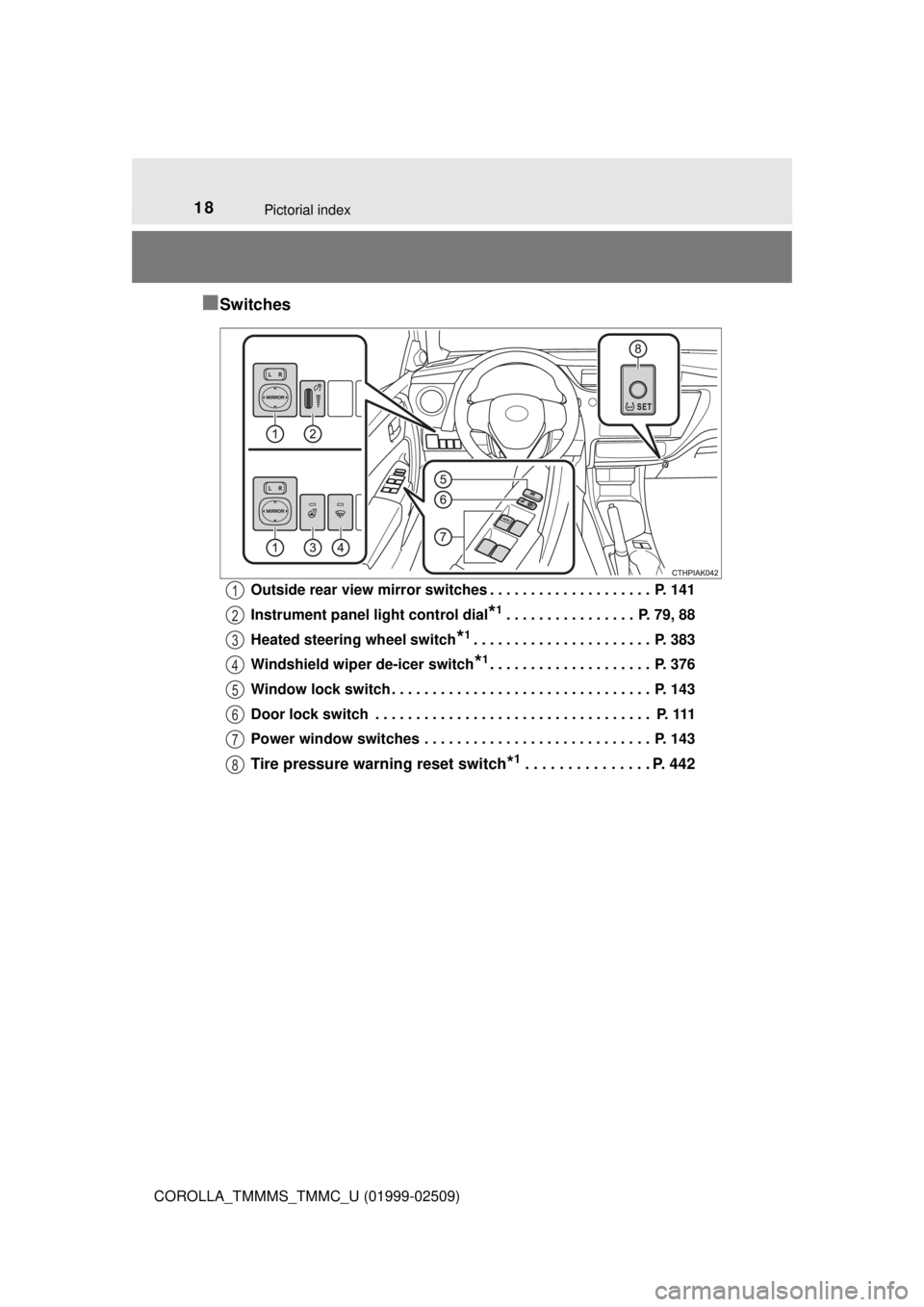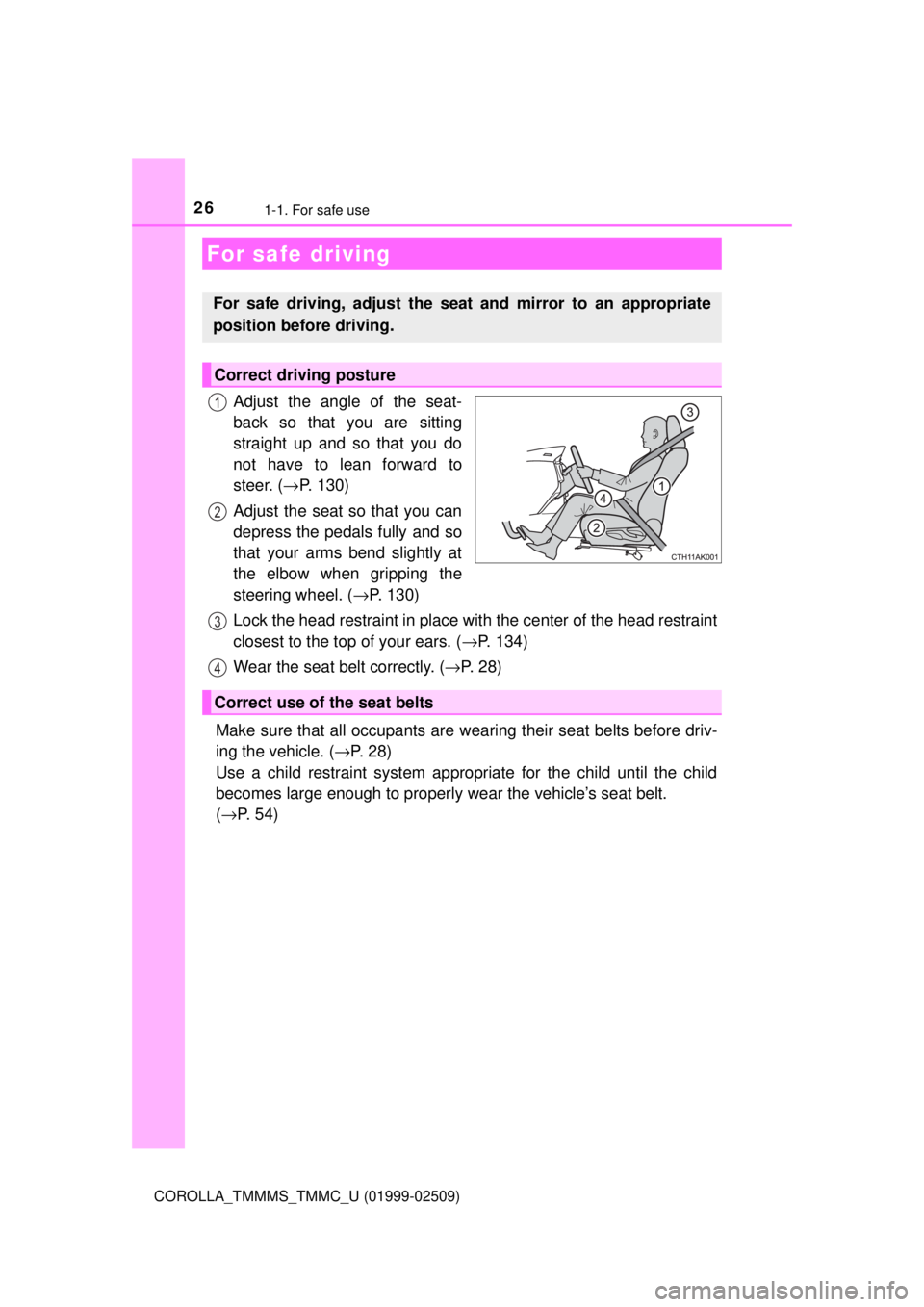wheel TOYOTA COROLLA 2018 Owners Manual (in English)
[x] Cancel search | Manufacturer: TOYOTA, Model Year: 2018, Model line: COROLLA, Model: TOYOTA COROLLA 2018Pages: 608, PDF Size: 9.96 MB
Page 3 of 608

3
1
9 8 6 5
4
3
2
COROLLA_TMMMS_TMMC_U (01999-02509)
10
7
3-1. Key informationKeys .................................. 102
3-2. Opening, closing and locking the doors
Doors................................. 108
Trunk ................................. 117
Smart key system.............. 122
3-3. Adjusting the seats Front seats ........................ 130
Rear seats ......................... 132
Head restraints .................. 134
3-4. Adjusting the steering wheel and mirrors
Steering wheel .................. 137
Inside rear view mirror....... 139
Outside rear view mirrors ............................. 141
3-5. Opening and closing the windows
Power windows ................. 143
Moon roof .......................... 147 4-1. Before driving
Driving the vehicle ............. 152
Cargo and luggage ............ 163
Vehicle load limits .............. 166
Trailer towing ..................... 167
Dinghy towing (vehicles with a continuously
variable transmission) ..... 168
Dinghy towing (vehicles with a manual
transmission) ................... 169
4-2. Driving procedures Engine (ignition) switch (vehicles without a
smart key system) ........... 171
Engine (ignition) switch (vehicles with a
smart key system) ........... 174
Continuously variable transmission (vehicles
without paddle shift
switches) ......................... 181
Continuously variable transmission (vehicles
with paddle shift
switches) ......................... 184
Manual transmission.......... 189
Turn signal lever ................ 191
Parking brake .................... 192
4-3. Operating the lights and wipers
Headlight switch ................ 193
Automatic High Beam ........ 198
Windshield wipers and washer ...................... 202
3Operation of each
component4Driving
Page 4 of 608

TABLE OF CONTENTS4
COROLLA_TMMMS_TMMC_U (01999-02509)4-4. Refueling
Opening the fuel tank cap .......................... 204
4-5. Using the driving support systems
Toyota Safety Sense P ..... 207
PCS (Pre-Collision System) .... 214
LDA (Lane Departure Alert with steering
control) ............................ 226
Dynamic radar cruise control ............................. 235
Rear view monitor system............................. 247
Driving assist systems....... 257
4-6. Driving tips Winter driving tips.............. 263
5-1. Basic Operations Audio system types ........... 270
Steering wheel audio switches .......................... 271
AUX port/USB port ............ 272
Entune Audio..................... 273
Basic audio operations ...... 276
5-2. Setup Setup menu ....................... 278
General settings ................ 279
Audio settings.................... 281
Display settings ................. 282
Voice settings .................... 283 5-3. Using Entune Audio
Selecting the audio source.............................. 284
List screen operation ......... 285
Optimal use of Entune Audio ................... 287
5-4. Using the radio Radio operation ................. 288
5-5. Playing an audio CD and MP3/WMA/AAC discs
CD player operation........... 290
5-6. Using an external device
Listening to an iPod ........... 296
Listening to a USB memory device ................ 301
Using the AUX port ............ 305
5-7. Connecting Bluetooth
®
Preparations to use wireless
communication ................ 306
Registering a Bluetooth
®
audio player for the
first time ........................... 310
Registering a Bluetooth
®
phone for the
first time ........................... 311
Registering a Bluetooth
®
device .............................. 312
Connecting a Bluetooth
®
device .............................. 315
Displaying a Bluetooth
®
device details................... 318
Detailed Bluetooth
®
system settings................ 319
5Audio system
Page 5 of 608

5
1
9 8 6 5
4
3
2
COROLLA_TMMMS_TMMC_U (01999-02509)
10
7
5-8. Bluetooth® Audio
Listening to Bluetooth®
Audio ............................... 320
5-9. Bluetooth
® phone
Using a Bluetooth®
Phone.............................. 322
Making a call ..................... 325
Receiving a call ................. 328
Speaking on the phone ..... 329
Bluetooth
® phone
message function ............ 333
Using the steering wheel switches .......................... 338
Bluetooth
® phone
settings............................ 339
Contact/ Call History Settings........ 341
What to do if... (Troubleshooting) ............ 351
5-10. Bluetooth
®
Bluetooth®......................... 355
5-11. Using the voice command system
Voice command system............................. 359 6-1. Using the air
conditioning system
and defogger
Manual air conditioning system ............................. 366
Automatic air conditioning system ............................. 373
Heated steering wheel/ seat heaters..................... 382
6-2. Using the interior lights Interior lights list................. 384
• Front interior light/personal lights ............... 385
• Rear interior light ........... 386
6-3. Using the storage features
List of storage features ...... 387
• Glove box ...................... 388
• Console box .................. 388
• Bottle holders ................ 389
• Cup holders ................... 390
6-4. Other interior features Other interior features........ 392
• Sun visors ..................... 392
• Vanity mirrors ................ 392
• Clock ............................. 392
• Outside temperature display ........................... 393
• Power outlet .................. 394
• Assist grips .................... 395
Garage door opener .......... 396
Compass ........................... 403
6Interior features
Page 6 of 608

TABLE OF CONTENTS6
COROLLA_TMMMS_TMMC_U (01999-02509)7-1. Maintenance and care
Cleaning and protecting the vehicle exterior .......... 408
Cleaning and protecting the vehicle interior ........... 411
7-2. Maintenance Maintenance requirements ................... 414
General maintenance ........ 417
Emission inspection and maintenance (I/M)
programs ......................... 421
7-3. Do-it-yourself maintenance
Do-it-yourself service precautions ..................... 422
Hood.................................. 425
Positioning a floor jack ...... 427
Engine compartment ......... 429
Tires .................................. 440
Tire inflation pressure........ 448
Wheels .............................. 451
Air conditioning filter .......... 453
Wireless remote control/ electronic key battery ...... 455
Checking and replacing fuses ............................... 458
Light bulbs ......................... 461 8-1. Essential information
Emergency flashers ........... 470
If your vehicle has to be stopped in an
emergency....................... 471
8-2. Steps to take in an emergency
If your vehicle needs to be towed .......................... 473
If you think something is wrong............................... 478
Fuel pump shut off system ............................. 479
If a warning light turns on or a warning buzzer
sounds ............................. 480
If a warning message or indicator is displayed ....... 489
If you have a flat tire .......... 509
If the engine will not start ........................... 521
If the electronic key does not operate properly ........ 523
If the vehicle battery is discharged ....................... 526
If your vehicle overheats......................... 531
If the vehicle becomes stuck ................................ 534
7Maintenance and care8When trouble arises
Page 18 of 608

18Pictorial index
COROLLA_TMMMS_TMMC_U (01999-02509)
■Switches
Outside rear view mirror switches . . . . . . . . . . . . . . . . . . . . P. 141
Instrument panel light control dial
*1. . . . . . . . . . . . . . . . P. 79, 88
Heated steering wheel switch
*1. . . . . . . . . . . . . . . . . . . . . . P. 383
Windshield wiper de-icer switch
*1. . . . . . . . . . . . . . . . . . . . P. 376
Window lock switch . . . . . . . . . . . . . . . . . . . . . . . . . . . . . . . . P. 143
Door lock switch . . . . . . . . . . . . . . . . . . . . . . . . . . . . . . . . . . P. 111
Power window switches . . . . . . . . . . . . . . . . . . . . . . . . . . . . P. 143
Tire pressure warning reset switch*1. . . . . . . . . . . . . . . P. 442
1
2
3
4
5
6
7
8
Page 26 of 608

261-1. For safe use
COROLLA_TMMMS_TMMC_U (01999-02509)
Adjust the angle of the seat-
back so that you are sitting
straight up and so that you do
not have to lean forward to
steer. (→P. 130)
Adjust the seat so that you can
depress the pedals fully and so
that your arms bend slightly at
the elbow when gripping the
steering wheel. ( →P. 130)
Lock the head restraint in place with the center of the head restraint
closest to the top of your ears. ( →P. 134)
Wear the seat belt correctly. ( →P. 2 8 )
Make sure that all occupants are we aring their seat belts before driv-
ing the vehicle. ( →P. 2 8 )
Use a child restraint system appropriate for the child until the child
becomes large enough to properly wear the vehicle’s seat belt.
( → P. 54)
For safe driving
For safe driving, adjust the seat and mirror to an appropriate
position before driving.
Correct driving posture
1
2
Correct use of the seat belts
3
4
Page 37 of 608

371-1. For safe use
1
For safety and security
COROLLA_TMMMS_TMMC_U (01999-02509)
Your vehicle is equipped with ADVANCED AIRBAGS designed based
on the US motor vehicle safety standards (FMVSS208). The airbag
sensor assembly (ECU ) controls airbag deployment based on infor-
mation obtained from the sensors et c. shown in the system compo-
nents diagram above. This informat ion includes crash severity and
occupant information. As the airbags deploy, a chemical reaction in
the inflators quickly fills the airbag s with non-toxic gas to help restrain
the motion of the occupants.
WARNING
■ SRS airbag precautions
Observe the following precautions regarding the SRS airbags.
Failure to do so may cause death or serious injury.
● The driver and all passengers in the vehicle must wear their seat belts
properly.
The SRS airbags are supplemental devices to be used with the seat belts.
● The SRS driver airbag deploys with considerable force, and can cause
death or serious injury especially if the driver is very close to the airbag.
The National Highway Traffic Safety Administration (NHTSA) advises:
Since the risk zone for the driver’s airbag is the first 2 - 3 in. (50 - 75 mm)
of inflation, placing yourself 10 in. (250 mm) from your driver airbag pro-
vides you with a clear margin of safety. This distance is measured from
the center of the steering wheel to your breastbone. If you sit less than 10
in. (250 mm) away now, you can change your driving position in several
ways:
• Move your seat to the rear as far as you can while still reaching the ped- als comfortably.
• Slightly recline the back of the seat.
Although vehicle designs vary, many drivers can achieve the 10 in. (250
mm) distance, even with the driver seat all the way forward, simply by
reclining the back of the seat somewhat. If reclining the back of your
seat makes it hard to see the road, raise yourself by using a firm, non-
slippery cushion, or raise the seat if your vehicle has that feature.
• If your steering wheel is adjustable, tilt it downward. This points the air-
bag toward your chest instead of your head and neck.
The seat should be adjusted as recommended by NHTSA above, while
still maintaining control of the foot pedals, steering wheel, and your v\
iew
of the instrument panel controls.
Page 40 of 608

401-1. For safe use
COROLLA_TMMMS_TMMC_U (01999-02509)
WARNING
■SRS airbag precautions
● Do not attach anything to or lean any-
thing against areas such as the dash-
board, steering wheel pad and lower
portion of the instrument panel.
These items can become projectiles
when the SRS driver, front passenger
and driver’s knee airbag deploy.
● Do not attach anything to areas such as
the door, windshield glass, side door
glass, front or rear pillar, roof side rail
and assist grip.
● Vehicles without a smart key system:
Do not attach any heavy, sharp or hard
objects such as keys and accessories
to the key. The objects may restrict the
SRS driver’s knee airbag inflation or be
thrust into the driver's seat area by the
force of the deploying airbag, thus caus-
ing a danger.
Page 41 of 608

411-1. For safe use
1
For safety and security
COROLLA_TMMMS_TMMC_U (01999-02509)
WARNING
■SRS airbag precautions
● If a vinyl cover is put on the area where the SRS driver’s knee airbag will
deploy, be sure to remove it.
● Do not use seat accessories which cover the parts where the SRS side
airbags and SRS seat cushion airbag inflate as they may interfere with
inflation of the SRS airbags. Such accessories may prevent the side air-
bags and seat cushion airbag from activating correctly, disable the system
or cause the side airbags and seat cushion airbag to inflate accidentally,
resulting in death or serious injury.
● Do not strike or apply significant levels of force to the area of the SRS air-
bag components.
Doing so can cause the SRS airbags to malfunction.
● Do not touch any of the component parts immediately after the SRS air-
bags have deployed (inflated) as they may be hot.
● If breathing becomes difficult after the SRS airbags have deployed, open a
door or window to allow fresh air in, or leave the vehicle if it is safe to do
so. Wash off any residue as soon as possible to prevent skin irritation.
● If the areas where the SRS airbags are stored, such as the steering wheel
pad and front and rear pillars garnishes, are damaged or cracked, have
them replaced by your Toyota dealer.
● Do not place anything, such as a cushion, on the front passenger's seat.
Doing so will disperse the passenger's weight, which prevents the sensor
from detecting the passenger's weight properly. As a result, the SRS front
airbags for the front passenger may not deploy in the event of a collisi\
on.
■ Modification and disposal of SRS airbag system components
Do not dispose of your vehicle or per form any of the following modifications
without consulting your Toyota dealer. The SRS airbags may malfunction or
deploy (inflate) accidentally, causing death or serious injury.
● Installation, removal, disassembly and repair of the SRS airbags
● Repairs, modifications, removal or replacement of the steering wheel,
instrument panel, dashboard, seats or seat upholstery, front, side and rear
pillars or roof side rails
● Repairs or modifications of the front fender, front bumper, or side of the
occupant compartment
● Installation of a grille guard (bull bars, kangaroo bar, etc.), snow plows,
winches or roof luggage carrier
● Modifications to the vehicle’s suspension system
● Installation of electronic devices such as mobile two-way radios and CD
players
● Modifications to your vehicle for a person with a physical disability
Page 42 of 608

421-1. For safe use
COROLLA_TMMMS_TMMC_U (01999-02509)
■If the SRS airbags deploy (inflate)
●Slight abrasions, burns, bruising etc.,may be sustained from SRS airbags,
due to the extremely high speed deployment (inflation) by hot gases.
● A loud noise and white powder will be emitted.
● Parts of the airbag module (steering wheel hub, airbag cover and inflat\
or) as
well as the front seats, parts of the front and rear pillars, and roof side rails,
may be hot for several minutes. The airbag itself may also be hot.
● The windshield may crack.
■ SRS airbag deployment conditions (SRS front airbags)
●The SRS front airbags will deploy in the event of an impact that exceeds the
set threshold level (the level of force corresponding to an approximately 12 -
18 mph [20 - 30 km/h] frontal collision with a fixed wall that does not move or
deform).
However, this threshold velocity will be considerably higher in the following
situations:
• If the vehicle strikes an object, such as a parked vehicle or sign pole, which can move or deform on impact
• If the vehicle is involved in an underride collision, such as a collision in
which the front of the vehicle “underrides”, or goes under, the bed of a
truck
● Depending on the type of collision, it is possible that only the seat belt pre-
tensioners will activate.
● The SRS front airbags for the front passenger will not activate if there is no
passenger sitting in the front passenger seat. However, the SRS front air-
bags for the front passenger may deploy if luggage is put in the seat, even if
the seat is unoccupied.
● The SRS seat cushion airbag on the front seats will not operate if the occu-
pant is not wearing a seat belt.
■ SRS airbag deployment conditions (S RS side and curtain shield airbags)
● The SRS side and curtain shield airbags will deploy in the event of an
impact that exceeds the set threshold level (the level of force corresponding
to the impact force produced by an approximately 3300 lb. [1500 kg] vehi\
cle
colliding with the vehicle cabin from a direction perpendicular to the vehicle
orientation at an approximate speed of 12 - 18 mph [20 - 30 km/h]).
● The SRS curtain shield airbags will deploy in the event of vehicle rollover.
● The SRS side and curtain shield airbags will deploy in the event of a severe
frontal collision.